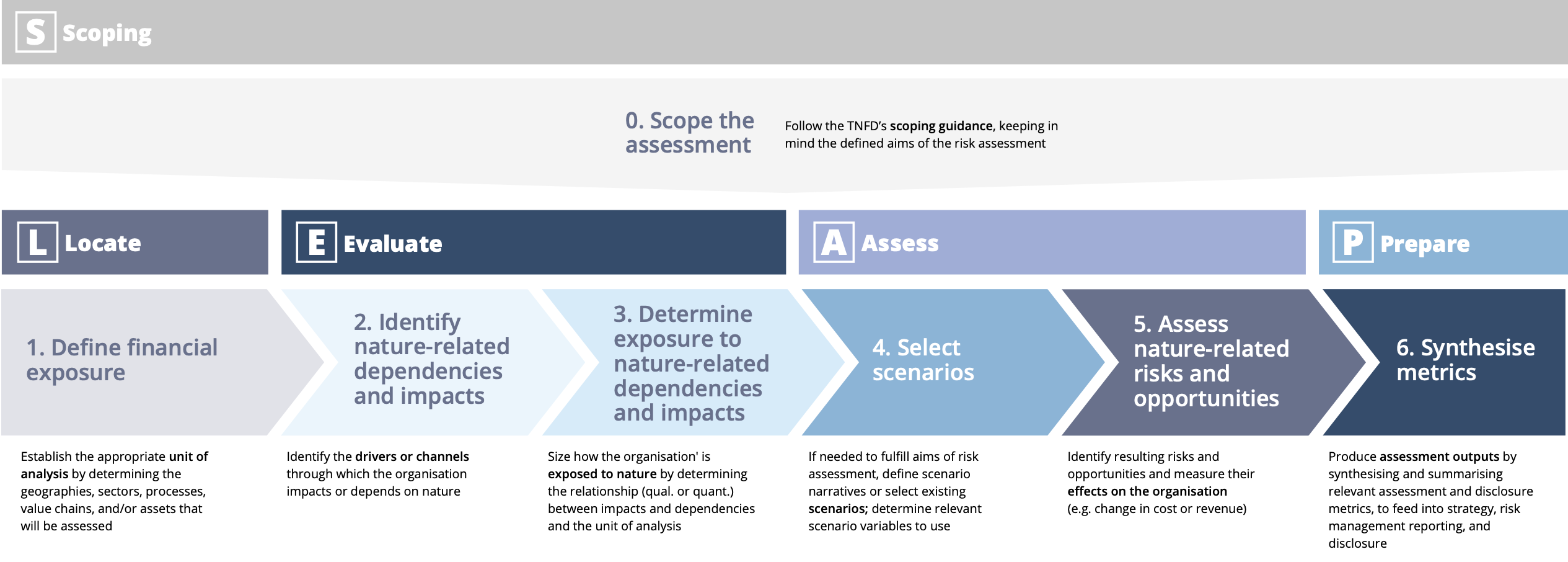
Making the LEAP: Three steps to get ready for the TNFD’s nature risk assessment
19 September 2023
After almost two years in the making, the Taskforce on Nature-related Financial Disclosures (TNFD) has unveiled its final recommendations for reporting of nature-related financial information. This framework seeks to bring nature onto the balance sheet, allowing organizations to measure and manage nature risks affecting their organization and identify opportunities for prevention and mitigation.
Now that the final details of the TNFD’s framework are known, there are actions organizations can take – alongside or as part of their work on climate risk – to get ahead of the curve on nature-related risk assessment and reporting. Sustana and Baringa worked together to do just that, through the assessment of Sustana’s nature-related risks and opportunities informing resilience planning and business decisions.
In this article, we’ll share important insights from our collaboration on Sustana’s LEAP assessment. Most importantly, we’ve used our experience to outline a set of three key steps that other organizations can take to guide their nature-related risk and opportunity assessments:
1. Set your scope
2. Consider your capabilities
3. Decide on your data tools
But before we dive in, let’s take a step back and answer some important questions about the TNFD and what sets it apart from existing climate-focused reporting frameworks.
What is the TNFD, and why should businesses be paying attention to it?
The TNFD is a global initiative to develop and deliver a risk management and disclosure framework for organizations to report on nature-related risks and opportunities. The framework gives companies a common way to measure how changes in environmental assets and ecosystem services might impact their operations, assets, suppliers, and customers, as well as identify opportunities that can arise from protecting and strengthening nature. Ultimately, the TNFD aims to support a shift in global financial flows away from nature-negative outcomes and toward nature-positive ones.
While financial disclosures based on the TNFD’s recommendations are currently voluntary, to us the direction is clear. Just as we’re seeing with climate-related disclosures, it’s only a matter of time before reporting on nature-related risks becomes part of mandatory regulatory frameworks. Additionally, with climate laying the groundwork, nature-related standards could be translated into regulation even faster. Consider the International Sustainability Standards Board (ISSB), which has confirmed that it will integrate TNFD work into its Sustainability Disclosure Standards, set to take effect from January 1, 2024.
The longer a company waits to develop its nature risk management and reporting capability, the greater the risk of exposure in a rising regulatory tide – and the more difficult and expensive it will be to catch up. In contrast, organizations like Sustana that get ahead of the curve now stand to reap the greatest rewards. They’ll establish a clearer picture of the risks that nature degradation and loss pose to their business and its bottom line. They will also uncover new opportunities from nature-positive business models. By doing so, companies can correctly quantify and manage risk, identify gaps in their environmental, social, and corporate governance (ESG) framework, make more informed capital allocation decisions, and expand organizational value.
How does the TNFD compare to the TCFD’s climate framework?
Fortunately for organizations just getting started on nature-related disclosure and risk management, the TNFD has been designed to maximize interoperability with an existing, similarly named framework – the Taskforce on Climate-Related Financial Disclosure (TCFD).
The TNFD takes much of its structure and approach from its climate-related predecessor. It defines physical, transition, and systemic risks in the same way, retains the TCFD’s disclosure recommendation pillars – governance, strategy, risk management, metrics, and targets – and adopts its scope concept and scenario analysis model. In time, we also expect to see more organizations producing joint TNFD and TCFD reports as part of their wider sustainability risk management and disclosure efforts.
However, there is an important distinction between the two frameworks. The nature-related risks that the TNFD focuses on are arguably much more difficult to quantify and address than the climate-related risks covered by the TCFD. Unlike greenhouse gas emissions, which can be measured in tons of carbon dioxide equivalents, nature has no single unit of measurement. Likewise, while there is a clear climate target of limiting global warming to 1.5°C above pre-industrial levels, nature and biodiversity are vast. For example, a key target of the Kunming-Montreal Global Biodiversity Framework aims to conserve at least 30% of the earth’s surface by 2030, which is much harder to attribute to individual companies.
Analyzing and acting on nature risk will take all-new thinking, data, and tools. Recognizing this reality, the TNFD has developed a unique assessment approach – known as LEAP – that organizations can use to guide their activities around nature-related risk and opportunity measurement and reporting.
What is LEAP?
LEAP is the TNFD’s assessment process for nature-related risk and opportunity management. It involves four core stages of analytic activity: locate proximity to environmental assets and ecosystem services, evaluate nature dependencies and impacts, assess nature-related risks and opportunities, and prepare to respond and report on them.

LEAP allows companies to take a preventative approach by establishing a baseline of their current impacts and dependencies. If your organization is keen to start assessing its capabilities in relation to the TNFD’s framework, we’ve defined three key steps for guiding your efforts – distilled from our experiences working on Sustana’s LEAP assessment.
Step 1: Set your scope
The LEAP approach encourages users to carefully consider the scope of their assessment before getting started with any other activities – and for good reason. When it comes to nature-related disclosures, scope is everything. That’s because most organizations will find that their operations involve or are influenced by countless environmental assets, ecosystem services, and interactions, across many different locations and channels of interaction.
“Defining your scope is phase zero of LEAP – and it’s absolutely critical for enabling every other phase that follows. Scope matters because nature risk covers an incredibly broad and complex array of factors. If you don’t define a clear scope, you could find yourself in a situation where you haven’t accounted for the data that’s necessary to support your assessment, and measurement and reporting quickly becomes unmanageable.”- Kathryn Beros, Expert in Consumer Products and Environmental Impact, Baringa
This makes it critical to carefully consider and define the boundaries of your data collection and disclosure intent. Defining this scope upfront allows an organization to identify initial areas of focus for further assessment. Here, broadly speaking, you have three approaches to choose from.
1. Pilot – your organization’s own operations or a single part of your value chain;
2. Phased approach – selected assets within your own operations and those in your organization’s value chain(s);
3. Full disclosure – own operations and wider value chain(s).
The ultimate goal is to gain visibility over all assets – both within your operations and outside of them – but trying to tackle everything at once can feel overwhelming at first. This is also a new space, so requirements and best practices will continue to evolve.
Nevertheless, that shouldn’t put you off getting started. The pressure to assess and disclose will only intensify with time – businesses should prepare sooner rather than later. Start small and build up from there. Sustana, for instance, chose the pilot approach for their initial LEAP assessment, focusing on nature-related risks and opportunities within the scope of their own operations.
When it comes to building a base of data assets, you’ll want to establish a centralized store of data as this will be essential for creating a reliable and consistent reporting baseline. Focus on building a clear view of data ownership, and work to consolidate data as much as you can to reduce redundancy and inaccuracy. Finally, make sure the data can be readily accessed by the relevant people, and avoid having key information siloed with a single owner, whether that’s an individual or team.
Step 2: Consider your capabilities
Once you’ve defined the scope that you’d like to cover with your assessments, you’ll need to think about what capabilities you’ll need to capture and analyze nature-related risks in line with the TNFD’s framework. These capabilities lie on two fronts – your internal operations and external value chain.
Internal
Location is fundamental to understanding an organization’s dependencies and impact on nature. You’ll need to build a geospatial picture of where your key activities occur and asset boundaries lie. Your people have a key role to play in shaping this view. Internally, you’ll want to gather feedback from multiple individuals across a variety of relevant teams.
Sustana, for example, has led extensive conversations with teams across operations, facilities, procurement, and environment. These are all areas where roles tend to have more of a direct link in terms of nature impact and where people tend to be more aware of how their role intersects with and impacts the environment.
On the topic of awareness, this is another essential capability to develop. If people aren’t aware of the environmental impact of their role, then you won’t be able to accurately understand or measure your organization’s total nature impact. It’s therefore vital to increase people’s awareness of how their role, and the operations sustained by it, affects and depends on nature.
“I think people know how their work is critical for the company's operations to run smoothly. But what they don't necessarily realize is how it plays into the nature side of things. That’s why opening up a dialogue is so important. It allows people to make a step change from thinking, ‘What is my impact in the organization?’ to ‘What is my work in the organization doing to impact nature?’”
- Srishti Srivastava, Sustainability Specialist, Sustana
To help build this awareness, you need to go beyond one-way data collection. Use data gathering as an opportunity to open a two-way conversation with business teams, allowing people to learn more about nature-related concepts and incorporate them into their day-to-day work. Space these conversations out over time and keep them specific to each team’s functional context. This will allow for information to be digested, applied, and observed with tangible examples as engagement and investment grows across the business.
External (value chain)
Depending on the scope you have defined for your LEAP assessment activities, you will also need to gather data on your organization’s value chain locations, both upstream (supply) and downstream (consumer).
Data collection should be an iterative process, incorporating input and feedback from your suppliers along the way. We strongly advise establishing a central location for data storage that offers privacy and security for participating suppliers.
Right now, many companies will face challenges in gathering the required data from their value chain. Even if they choose to analyze a subset of the value chain, they’ll likely encounter issues around data availability and sharing, as well as analytical limitations. In any case, the absence of complete data should not stop organizations from starting to report. Value chain reporting will improve over time as more institutions ramp up their disclosure efforts and new tools and standards improve data integrity, transparency, and availability.
Step 3: Decide on your data tools
Your third step is to select the tools that will support you in locating, evaluating, and assessing nature-related risks and opportunities.
The TNFD tools catalogue currently lists more than 100 data tools that organizations can apply to each phase of the LEAP approach. Additional data tools, with different specializations and capabilities, continue to enter the market. Not all will be useful, depending on how you intend to approach LEAP and your internal and external capabilities. To help your organization determine which tools will be most relevant and useful, consider the following points.
Breadth vs. depth
Some data tools are very broad and cover a wider section of disclosure requirements, albeit with lower resolution. Meanwhile, other tools are specific to certain regions and offer much higher-resolution data availability. That’s why defining your boundaries is critical – you’ll need this to determine which tools work best for your scope and goals.
Available resources
Not all data tools are free to use; the costs of certain tools can reach tens of thousands of dollars. It’s important to understand exactly what tools will support your efforts, and if you have the budget to cover them. As the final stage of the LEAP approach is all about preparing to report on your nature risk, the tools you select should also be ones that enable reporting (which might be internal to start with) on your chosen metrics.
Likewise, you should assess whether you have the internal capacity required to deploy your chosen tools effectively. Some data collection tools, for instance, include lengthy question sets. What processes do you need to put in place and who needs to be engaged to distribute those questionnaires, gather and analyze the responses, and complete follow-up interviews as necessary?
A final point to consider is that these are still early days for nature-related risk management, which means that the space is also evolving quickly. The work done today will need to be revisited as more solutions become available, data resolution improves, and scenario tools that support more forward-looking LEAP approaches become available. You should continue to revisit this space as toolsets and approaches mature, ensuring that your business is best prepared to assess and act on nature risks and opportunities.
Our ongoing work with Sustana shows the value of being well-prepared. By taking early, tangible action on TNFD’s recommendations, they’re putting themselves in a strong position to manage nature-related risks and opportunities and make the most of the nature-positive transition.
What’s the best way for your business to approach nature-related risk management and reporting? Baringa is ready to help you get started. Please get in touch with us for more information.
Related Insights

Preparing for the EU's regulation on deforestation-free products
Is your supply chains prepared for the incoming EU Deforestation Regulation? In this article we share what you need to know in preparation for the new regulation, and how Baringa can help you.
Read more
Achieving the benefits of a multi-brand product portfolio
Download our blog on achieving the benefits of a multi-brand product portfolio.
Read more
Trading team optimisation: time to add value
Trading team optimisation: How team structures and ways of working can help trading teams make fast, informed decisions.
Read more
Become digital podcast: Episode 2 - Pret a Manger
Baringa are joined by Pret a Manger to discuss their digital journey, strategies, response to Covid-19, Pret's coffee subscription service and more
Read moreRelated Client Stories

Freeing up £500m+ in cost savings for investment in new growth and future value at a global FMCG business
How can you improve margin, boost operational resilience and accelerate innovation across a global business?
Read more
Transforming digital capabilities for one of the UK’s best-loved food and coffee chains
Read about how we put our client’s users first to design market-leading digital products.
Read more
Helping an American personal care company become a truly digital business
How can you prepare for the future of e-commerce?
Read more
Restructuring a FTSE 10 health, hygiene and nutrition business into a multi business unit organisation
Read about restructuring a FTSE 10 health, hygiene and nutrition business into a multi business unit organisation.
Read moreIs digital and AI delivering what your business needs?
Digital and AI can solve your toughest challenges and elevate your business performance. But success isn’t always straightforward. Where can you unlock opportunity? And what does it take to set the foundation for lasting success?